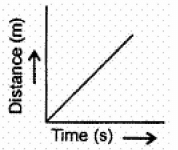Class 9 Science: Sample Question Paper Term I- 7 (With Solutions) | Science Class 9 PDF Download
| Table of contents |

|
| Class - IXTime: 90 |

|
| Max. Marks: 40 |

|
| Section - A |

|
| Section - B |

|
| Section - C |

|
Class - IX
Time: 90
Max. Marks: 40
General Instructions:
- The Question Paper contains three sections.
- Section - A has 24 questions. Attempt any 20 questions.
- Section - B has 24 questions. Attempt any 20 questions.
- Section - C has 12 questions. Attempt any 10 questions.
- All questions carry equal marks.
- There is NO negative marking.
Section - A
Q.1: Which of the following element has the characteristics of both metals and non-metals?
(a) Phosphorus
(b) Carbon
(c) Nitrogen
(d) Arsenic
Correct Answer is Option (d)
The element that possesses characteristic of both metal and non-metal are called metalloid. Arsenic is the element that has properties of both metal and non-metal. So, Arsenic is metalloid.
Q.2: One of the following is not a characteristic feature of parenchyma tissue. That feature is:
(a) cells are thin-walled and prominent
(b) a large single vacuole is present in each cell
(c) cells are thick at the corners
(d) large cells are placed together with intercellular spaces
Correct Answer is Option (c)
Intercellular spaces are present between the cells. Cells are thin-walled (primary wall only except wood parenchyma), with large vacuole and wide intercellular spaces. Cells of Parenchyma tissue are isodiametric.
Cells are thick at the corners is not a characteristic feature of parenchyma tissue.
Q.3: While doing work and running, you move your organs like hands, legs, etc. Which among the following is correct?
(a) Skeletal muscles contract and pull the tendon to move the bones
(b) Smooth muscles contract and pull the ligament to move the bones
(c) Skeletal muscles contract and pull the ligament to move the bones
(d) Smooth muscles contract and pull the tendons to move the bones
Correct Answer is Option (a)
Skeletal muscles are striped, voluntary muscles, due to the presence of alternate dark and light bands. They are called voluntary as they work according to our will. While doing work and running skeletal muscles contract and pull the tendon (which connects muscles to bones) to move the bone.
Q.4: Match the following with the correct response.
(a) (A) - (iv), (B) - (i), (C) - (iii), (D) - (ii)
(b) (A) - (i), (B) - (iii), (C) - (ii), (D) - (iv)
(c) (A) - (iii), (B) - (ii), (C) - (iv), (D) - (i)
(d) (A) - (ii), (B) - (iv), (C) - (i), (D) - (iii)
Correct Answer is Option (c)
Acceleration of a body is defined as the rate of change of its velocity with time.
The velocity of a body is defined as the rate of change of its displacement with time.
The speed of a body is the distance travelled by it per unit time.
When a body moves along a circular path, then its direction of motion keeps changing continuously. Therefore, the motion along a circular path is said to be accelerated.
Q.5: If the friction acting on the body is more, the body will move:
(a) No change in speed
(b) Less speedily
(c) Same speed
(d) More speedily
Correct Answer is Option (b)
Less speedily as it cancels the force which moves it as friction is the force acting opposite to the moving body and frictional force will never be more because frictional force exerts an equal force back to the body.
Q.6: A student added only two drops of iodine to a rice extract in test tube 'A'. Another student added a little rice extract to iodine solution in test tube 'B'. They would then observe:
(a) no change of colour in any test tube
(b) a change of colour to blue-black in both tubes 'A' and 'B'
(c) a change of colour to blue-black in test tube 'B' but not in test tube 'A'
(d) a change of colour to blue-black in test tube 'A' but not in test tube 'B'
Correct Answer is Option (b)
Iodine + Starch Solution → Blue-black colour Starch act as an indicator of the presence of iodine.
Q.7: Which of the following is an incorrect pair?
A. Lysosome - Secretory granules.
B. Nucleus - Brain of the cell
C. Mitochondria - a powerhouse of the cell
D. Chloroplast - Kitchen of the cell
(a) (A)
(b) (D)
(c) (B)
(d) (C)
Correct Answer is Option (a)
Lysosomes are the suicidal bags that kill the cells which are turned off or damaged and became non-functional. They do not secrete anything rather possess some lytic enzymes membrane- bound.
Q.8: Contractile proteins are present in ______ tissue.
(a) areolar
(b) adipose
(c) nervous
(d) muscular
Correct Answer is Option (d)
Contractile proteins are found in muscles, as they are associated with the movement of the body or limbs. The contraction and relaxation of contractile proteins, present in muscles bring about movements of limbs, internal organs, etc.
Q.9: Which of the following figures represent uniform motion of moving object correctly?
(a)
(b)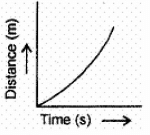
(c)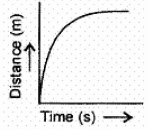
(d)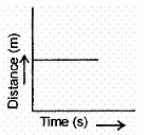
Correct Answer is Option (a)
Uniform motion of a moving object
Q.10: The physical quantity which is equal to the rate of change of momentum is:
(a) impulse
(b) power
(c) energy
(d) force
Correct Answer is Option (d)
Rate of change of momentum (final momentum-initial momentum)/time taken
= (mv - mu)/t
= m(v - u)
= ma
= F
Q.11: Metanil yellow, an adulterant used in Arhar dal is basically:
(a) a dye
(b) an acid
(c) a detergent
(d) a base
Correct Answer is Option (a)
Metanil yellow is a yellow colour dye, generally used colouring food material, for e.g. starch when dyed with metanil yellow looks like turmeric. Poor quality dal when dyed with metanil yellow looks superior quality dal.
Q.12: Ribosomes are the centre for:
(a) Respiration
(b) Fat synthesis
(c) Photosynthesis
(d) Proteins synthesis
Correct Answer is Option (d)
Protein synthesis involves the formation of amino acid chains according to information present on the DNA. The ribosomes, which are present in all active cells, are the sites for the manufacture of proteins. The proteins manufactured by the ribosomes are sent to other organelles in the cell. Some proteins function as enzymes and hormones.
Q.13: Which of these types of cells is most likely to divide?
(a) Meristem
(b) Epidermis
(c) Xylem
(d) Parenchyma
Correct Answer is Option (a)
The meristematic tissue is of the following types:
i. Apical meristem (responsible for vertical growth of root and shoot)
ii. Lateral meristem (responsible for the increase in girth of a stem)
iii. Intercalary meristem (responsible for the branching in a plant).
The three types of growth take place due to division in tissues.
Q.14: Rocket works on the principle of ______.
(a) Newton's third law
(b) Newton's second law
(c) Newton's fourth law
(d) Newton's first law
Correct Answer is Option (a)
Newton's third law of motion is: For every action, there is an equal and opposite reaction.
Q.15: Which of the following is a unit of weight?
(a) Quintal
(b) Kg
(c) Ton
(d) Newton
Correct Answer is Option (d)
The weight of an object is defined as the force of gravity on the object and may be calculated as the mass times the acceleration of gravity.
w = mg.
Since the weight is a force, its SI unit is the newton.
Q.16: A Substance can be beaten into sheets and beaten into wires. What will you call it?
(a) It is both brittle and lustrous
(b) It is both sonorous and ductile
(c) It is both malleable and ductile
(d) It is both malleable and brittle
Correct Answer is Option (c)
The property of metals by which they can be beaten into thin sheets is called malleability.
The property of metal by which it can be drawn into wires is called ductility.
Gold is the most malleable and ductile element.
Q.17: The cell sap in plant cells consists of:
(a) water + organic substances
(b) both (water only) and (water + inorganic substances)
(c) water only
(d) water + inorganic substances
Correct Answer is Option (b)
The liquid found inside the plant cell vacuole is referred to as the cell sap and it is a dilute fluid consisting of water, amino acids, glucose i.e. (water + inorganic substances), water may also be in habited with a negligible amount of salts because it somehow depends on the mineral excess inside the body of plants. The excess material is temporarily stored inside the cell sap. Thus, vacuoles act as storehouses in plants.
Q.18: The non-living cell of phloem is:
(a) Companion cells
(b) Phloem sclerenchyma
(c) Sieve tubes
(d) Phloem parenchyma
Correct Answer is Option (b)
Phloem is complex tissue consists of a sieve tube, companion cells, phloem parenchyma, and phloem sclerenchyma (fibre). Out of these, phloem sclerenchyma is non-living.
Q.19: A train is travelling at a speed of 90 km/h. Brakes are applied so as to produce a uniform acceleration of -0.5 m/s2. Find how far will the train go before it is brought to rest.
(a) 623 m
(b) 650 m
(c) 625 m
(d) 600 m
Correct Answer is Option (c)
Initial velocity (u) = 90 km/h
a = -0.5m/s2
v = 0 m/s
From third equation of motion,
v2 - u2 = 2aS
Q.20: If the initial velocity is zero then the force acting is ______.
(a) Acceleration
(b) Both
(c) Retarding
(d) None
Correct Answer is Option (c)
Retarding depends on the final velocity.
If final velocity is less then initial velocity then there will be retardation and viceversa.
Q.21: Arun has prepared 0.01% (by mass) solution of sodium chloride in water. Which of the following correctly represents the composition of the solutions?
(a) 1.00g of NaCl + 100g of water
(b) 0.10 g of NaCl + 99.90g of water
(c) 0.01g of NaCl + 99.99g of water
(d) 0.11g of NaCl + 100g of water
Correct Answer is Option (c)
Hence, the mass of solute = 0.01 g and the mass of solvent = 99.99 gms.
Q.22: A eukaryotic nucleus has a:
(a) non-porous, single membrane
(b) porous, single membrane
(c) porous, double membrane
(d) non-porous, double membrane
Correct Answer is Option (c)
The bounding structure of the eukaryotic nucleus. Composed of two phospholipid bilayers with the outer one connected to the endoplasmic reticulum. Double membrane structure riddled with pores that surround deoxyribonucleic acid in eukaryotes. The nuclear pores, like guards at an important government building, are very strict.
Q.23: The common characteristic of xylem tracheids and sieve tubes is that both are:
(a) thick-walled cells
(b) dead cells
(c) living cells
(d) meant for conduction
Correct Answer is Option (d)
Xylem is composed of tracheids, vessels, xylem parenchyma, and xylem fibres. Tracheids and vessels are tubular structures and thus they provide a channel for conduction of water and minerals. Phloem is composed of sieve tubes, companion cells, phloem fibre and phloem parenchyma. Sieve tubes are tubular cells with perforated walls. Sieve tubes are the conducting elements of phloem.
Q.24: Match the following with correct response.
(a) 1-D, 2-A, 3-C, 4-B
(b) 1-B, 2-D, 3-A, 4-C
(c) 1-C, 2-B, 3-D, 4-A
(d) 1-A, 2-C, 3-B, 4-D
Correct Answer is Option (b)
i. The SI unit of velocity is meter per second.
ii. The SI unit of acceleration is the metre per second square.
iii. The SI unit of displacement is the meter.
iv. Retardation is negative acceleration.Therefore its SI unit is metre per second squared with a negative sign.
Section - B
Q.25: If the force acting on the body is zero, its momentum is ______.
(a) Zero
(b) Negative
(c) Both
(d) Constant
Correct Answer is Option (d)
Force, F = dp/dt (Rate of change of momentum).
Therefore, only when the momentum is constant, will the acting force be Zero.
Q.26: Four cars A, B, C and D are moving on the levelled road. Their distance-time graph is given as under. The correct statement is:
(a) Car D is faster than car D
(b) Car A is faster than car D
(c) Car C is slowest
(d) Car B is slowest
Correct Answer is Option (d)
The slope of a distance time graph determines the speed of the body, so steeper the slope greater will be the speed of the body. From the above graph we can come to a conclusion that car C has the highest speed and car B has the least speed.
Q.27: Which of the following statement is/are correct:
A. Chlorophyll is found in the chloroplast.
B. The nucleus is surrounded by a single membrane called the nuclear membrane.
C. Plastids are coloured.
D. Chloroplast contains DNA.
(a) All of these
(b) B and C
(c) B and D
(d) A and D
Correct Answer is Option (d)
Chlorophyll is found in the chloroplast (green plastids). Chloroplast contains DNA. In plants, DNA or deoxyribonucleic acid is contained within the membrane-bound cell structures of the nucleus, mitochondria and chloroplasts. All plastids are not coloured.
Chromoplasts and chloroplasts are coloured plastids whereas leucoplasts are colourless. The nucleus is surrounded by a double membrane - the inner nuclear membrane and the outer nuclear membrane.
Q.28: Tendons help to connect
(a) muscle to muscle
(b) muscle to bone
(c) bone to cartage
(d) bone to bone
Correct Answer is Option (b)
A tendon is a fibrous connective tissue that attaches muscle to bone. Tendons may also attach muscles to structures such as the eyeball.
Q.29: Which structure is called the little nucleus?
(a) Chromosomes
(b) Nucleolus
(c) Genes
(d) DNA
Correct Answer is Option (b)
The nucleolus is present in the nucleus of the cell. It is called the little nucleus of the cell.
Q.30: If a moving body comes to rest, then it's acceleration is:
(a) Negative
(b) Positive
(c) Constant
(d) Zero
Correct Answer is Option (a)
If a moving body comes to rest, then its acceleration is negative, as it’s velocity becomes zero, therefore the acceleration is also zero.
Q.31: Assertion (A): In sublimation, a substance changes directly from solid to vapour without passing through liquid state and vice-versa.
Reason (R): Distillation involves two processes i.e., vaporisation and condensation.
(a) Both A and R are true and R is the correct explanation of A.
(b) Both A and R are true but R is not the correct explanation of A.
(c) A is true but R is false.
(d) A is false but R is true.
Correct Answer is Option (b)
Both are definitions of sublimation and distillation respectively.
Q.32: Assertion (A): Rahul’s mother was going to make pickle. For this, she cut the vegetables into small pieces and put them in the sun for few hours the pickle swells.
Reason (R): The vegetables lose all the water by diffusion and evaporation and become dry.
(a) Both A and R are true and R is the correct explanation of A.
(b) Both A and R are true but R is not the correct explanation of A.
(c) A is true but R is false.
(d) A is false but R is true.
Correct Answer is Option (d)
Rahul’s mother was going to make pickle. For this, she cut the vegetables into small pieces and put them in the sun for few hours the pickle shrinks. The vegetables lose all the water by diffusion and evaporation and become dry.
Q.33: Assertion (A): Cells of cork or bark are dead, acts as a protective covering.
Reason (R): In leguminous plants, the root nodules harbor nitrogen-fixing bacteria which convert atmospheric nitrogen into nitrates.
(a) Both A and R are true and R is the correct explanation of A.
(b) Both A and R are true but R is not the correct explanation of A.
(c) A is true but R is false.
(d) A is false but R is true.
Correct Answer is Option (b)
Cells of cork or bark are dead, compactly arranged without intercellular spaces, and have a chemical called subering in their walls that makes them impervious to gases and water. In this way, it acts as a protective tissue.
Q.34: Assertion (A): A boy is enjoying a ride on a merry-go-round which is moving at a constant speed of 10 m/s. The boy is in uniform accelerated motion.
Reason (R): A body has a uniform acceleration if it travels in a straight line and its velocity first decreases then increases by equal amounts in equal intervals of time.
(a) Both A and R are true and R is the correct explanation of A.
(b) Both A and R are true but R is not the correct explanation of A.
(c) A is true but R is false.
(d) A is false but R is true.
Correct Answer is Option (c)
A body has a uniform acceleration if it travels in a straight line and its velocity increases by equal amounts in equal intervals of time.
Q.35: Assertion (A): When a bullet is fired from a gun, there is a forward force on the bullet and recoil of gun.
Reason (R): Every action has an equal and opposite reaction.
(a) Both A and R are true and R is the correct explanation of A.
(b) Both A and R are true but R is not the correct explanation of A.
(c) A is true but R is false.
(d) A is false but R is true.
Correct Answer is Option (a)
Q.36: Match the following with the correct response.
(a) (a) - (ii), (b) - (iv), (c) - (i), (d) - (iii)
(b) (a) - (i), (b) - (iii), (c) - (ii), (d) - (iv)
(c) (a) - (iv), (b) - (i), (c) - (iii), (d) - (ii)
(d) (a) - (iii), (b) - (ii), (c) - (iv), (d) - (i)
Correct Answer is Option (c)
- A solution has a solvent and solute as its components. The component in the larger amount is the solvent.
- A solution has a solvent and solute as its components. The component in the lesser amount is the solute.
- A true solution is a homogeneous mixture.
- A suspension is a heterogeneous mixture of two or more substances.
Q.37: A body is moving with a velocity of 10m/s. If the motion is uniform, what will be the velocity after 10 second?
(a) 10 m/s
(b) 15 m/s.
(c) 5 m/s
(d) 20 m/s
Correct Answer is Option (a)
A body moving with uniform motion never changes its speed. So, the velocity of the body remains the same after 10 seconds that is 10m/s.
Q.38: Match the following with the correct response:

(a) (A) - (iii), (B) - (ii), (C) - (iv), (D) - (i)
(b) (A) - (ii), (B) - (iv), (C) - (i), (D) - (iii)
(c) (A) - (iv), (B) - (i), (C) - (iii), (D) - (ii)
(d) (A) - (i), (B) - (iii), (C) - (ii), (D) - (iv)
Correct Answer is Option (a)
- Genes are functional units of heredity that determine the characters of organisms,
- Diffusion is the process of passage of fluid from a region of high concentration to a region of low concentration. It plays an important role in the gaseous exchange between the cells as well as the cell and its external environment. Water also obeys the law of diffusion.
- The passage of water from a region of higher water concentration to a region of lower water concentration through a semi-permeable membrane is called osmosis. The movement of water across the plasma membrane is affected by the amount of substance dissolved in water.
- Plasmolysis refers to the contraction of protoplast as a result of the loss of water from the cell.
The shrinkage of cytoplasm occurs due to exo-osmosis in a hypertonic medium. A hypertonic solution is one that has a lesser concentration of water as compared to that inside the cell. During the process, there is a higher external osmotic pressure and a net flow of water from the cell.
Q.39: Following are a few definitions of osmosis read carefully and select the correct definition.
(a) Movement of solvent molecules from its higher concentration to lower concentration
(b) Movement of solvent molecules from higher concentration to lower concentration of solution through a permeable membrane
(c) Movement of solute molecules from lower concentration to higher concentration of solution through a semipermeable membrane
(d) Movement of water molecules from a region of higher concentration to a region of lower concentration through a semipermeable membrane
Correct Answer is Option (d)
Osmosis is the passive movement of water or any other solvent molecules from a region of higher water concentration to a region of lower water concentration through a semipermeable membrane.
Q.40: Which of the following conducts water and minerals in plants?
(a) Phloem
(b) Both Xylem and Phloem
(c) Xylem
(d) Fibres
Correct Answer is Option (c)
Xylem is composed of tracheids, vessels, xylem parenchyma, and xylem fibres. The cells of xylem are dead; except the cells of xylem parenchyma. Tracheids and vessels are tubular structures and thus they provide a channel for conduction of water and minerals.
Q.41: The only cell organelle seen in a prokaryotic cell is:
(a) Mitochondria
(b) Ribosomes
(c) Plastids
(d) Lysosomes
Correct Answer is Option (b)
Ribosomes are the only cell organelle seen in the prokaryotic cells. Ribosomes in prokaryotes are smaller than those in eukaryotes.
Q.42: Plasmolysis in a plant cell is defined as
(a) shrinkage of nucleoplasm
(b) shrinkage of cytoplasm in hypertonic medium
(c) break down (lysis) of plasma membrane in hypotonic medium
(d) shrinkage of nucleolus
Correct Answer is Option (b)
Plasmolysis is mainly known as shrinking of cell membrane in hypertonic solution and great pressure.
Q.43: Which of the following is the position-time graph for a body at rest?
(a)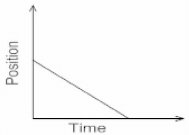
(b)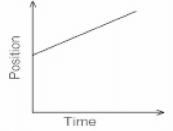
(c)
(d)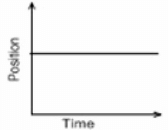
Correct Answer is Option (d)
The above graph shows an object which is not moving i.e. it is at rest.
The straight horizontal line parallel to the time axis shows that the distance covered by the body remains constant with the change in time.
Q.44: A student mixed the white of an egg with water and stirred it well. After sometimes he observe that:
(a) egg white settles down at the bottom
(b) a transparent solution is formed
(c) a translucent mixture is formed
(d) egg white floats on the surface of the water
Correct Answer is Option (c)
Egg white is translucent. Egg albumin forms colloidal solution which is translucent.
Q.45: Choose the correct observation about a solution of sugar in water prepared by you in the laboratory.
(a) Solid particles settle at the bottom after sometimes
(b) Its particles are seen by naked eyes
(c) It is transparent
(d) Its components can be separated by filtration
Correct Answer is Option (c)
A solution is always transparent, light passes through it without scattering as the solute particles are very small in size. So, the solution of sugar in water is transparent.
Q.46: Which of the following is not the function of Golgi bodies?
(a) Synthesis of lysosomes
(b) Protection to cell
(c) Formation of cell plate
(d) None of these
Correct Answer is Option (b)
The functions of the Golgi apparatus include the storage, modification, and packaging of products in vesicles. The material synthesized near the ER is packaged and dispatched to various targets inside and outside the cell through the Golgi apparatus. It is also involved in the formation of lysosomes. It helps in the formation of cell plate during cell division but it is not involved in the protection of cells.
Q.47: Statement A: Collagen occurs in yellow elastic fibre.
Statement B: Sclereids form a gritty part of ripe fruits.
Which of the two statements is/are true?
(a) Statement A
(b) Neither A nor B
(c) Statement B
(d) Statement A and B
Correct Answer is Option (d)
- A collagen is actually a group of proteins found naturally in the body. Elastic or yellow cartilage contains elastic fiber networks and collagen fibers,
- Sclereids from the gritty part of most of the ripe fruits and contribute hardness to the seed coat and nutshells.
Statement A and B are true statements.
Q.48: Which is the most widely distributed connective tissue?
(a) Blood
(b) Lymph
(c) Adipose connective tissue
(d) Areolar connective tissue
Correct Answer is Option (d)
Areolar connective tissue is the simplest and most widely distributed connective tissue. Areolar connective tissue is found between the skin and muscles, around blood vessels and nerves, and in the bone marrow.
Section - C
Read the text carefully and answer the questions:
Air is a homogeneous mixture and can be separated into its components by fractional distillation. The air is compressed by increasing the pressure and is then cooled by decreasing the temperature to get liquid air. This liquid air is allowed to warm-up slowly in a fractional distillation column, where gases get separated at different heights depending upon their boiling points. The properties that can be observed and specified like colour, hardness, rigidity, etc. are the physical properties. The interconversion of states is a physical change because these changes occur without a change in composition and no change in the chemical nature of the substance.
Q.49: Which of the following are chemical changes?
I. Decaying of wood
II. Burning of wood
III. Sawing of wood
IV. Hammering of a nail into a piece of wood
(a) (Ill) and (IV)
(b) (I) and (II)
(c) (I) and (IV)
(d) (II) and (III)
Correct Answer is Option (b)
Q.50: The boiling point of oxygen is
(a) -130°C
(b) -190°C
(c) -180°C
(d) -170°C
Correct Answer is Option (c)
Q.51: ______ is a process that separates a pure solid in the form of its crystals from a solution.
(a) Crystallisation
(b) None of these
(c) Distillation
(d) Simple evaporation
Correct Answer is Option (a)
Q.52: Which of the given are physical changes?
I. Melting of iron metal
II. Rusting of iron
III. Bending of an iron rod
IV. Drawing a wire of iron metal
(a) (I), (III) and (IV)
(b) (II), (III) and (IV)
(c) (I), (II) and (III)
(d) (I), (II) and (IV)
Correct Answer is Option (a)
Read the text carefully and answer the questions:
Leeuwenhoek discovered the free-living cells in pond water for the first time. Robert Brown discovered the nucleus in the cell. A single cell may constitute a whole organism as in Amoeba. These organisms are called unicellular organisms. On the other hand, many cells group together in a single body and assume different functions in it to form various body parts in multicellular organisms. The shape and size of cells are related to the specific function they perform. Each living cell has the capacity to perform certain basic functions that are characteristic of all living forms. Each kind of cell organelle performs a special function, such as making new material in the cell, clearing up the waste material from the cell and so on.
Q.53: Cells were first discovered by:
(a) Leeuwenhoek
(b) Virchow
(c) Robert Hooke
(d) Schleiden
Correct Answer is Option (c)
Q.54: Which of the following is a unicellular organism?
(a) Plants
(b) Fungi
(c) Animal
(d) Chlamydomonas
Correct Answer is Option (c)
Q.55: Who suggested that all cells arise from pre-existing cells?
(a) Leeuwenhoek
(b) Schleiden
(c) Robert Hooke
(d) Virchow
Correct Answer is Option (d)
Q.56: Which of the following is an incorrect statement?
I. Each living cell has the capacity to perform certain basic functions
II. There is a division of labour in multicellular organisms
III. Each kind of cell organelle performs a special function
IV. All activities inside the cell do not interact with the environment.
(a) (II) and (III)
(b) (I) and (II)
(c) (Ill) and (IV)
(d) Only (IV)
Correct Answer is Option (d)
Read the text carefully and answer the questions:
In the velocity-time graph for the motion of the car. The nature of the graph shows that velocity changes by equal amounts in equal intervals of time. For all uniformly accelerated motion, the velocity time graph is a straight line.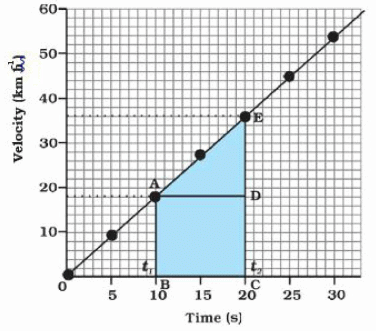 Q.57: The slope of a velocity-time graph gives
Q.57: The slope of a velocity-time graph gives
(a) the acceleration
(b) the speed
(c) the distance
(d) the displacement
Correct Answer is Option (a)
Q.58: Which of the following statement is correct regarding the velocity and speed of a moving body?
(a) The velocity of a moving body is its speed in a given direction.
(b) The speed of a moving body is always higher than its velocity.
(c) The velocity of a moving body is always higher than its speed.
(d) The speed of a moving body is its velocity in a given direction.
Correct Answer is Option (a)
Q.59: The following graphs shows: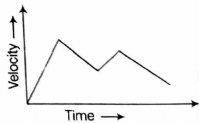 (a) uniformly decelerated motion
(a) uniformly decelerated motion
(b) uniformly accelerated motion
(c) non- uniformly decelerated motion
(d) non-uniformly accelerated motion
Correct Answer is Option (d)
Q.60: If the displacement of an object is proportional to square of time, then the object moves with:
(a) uniform velocity
(b) uniform acceleration
(c) decreasing acceleration
(d) increasing acceleration
Correct Answer is Option (b)
|
84 videos|478 docs|60 tests
|

